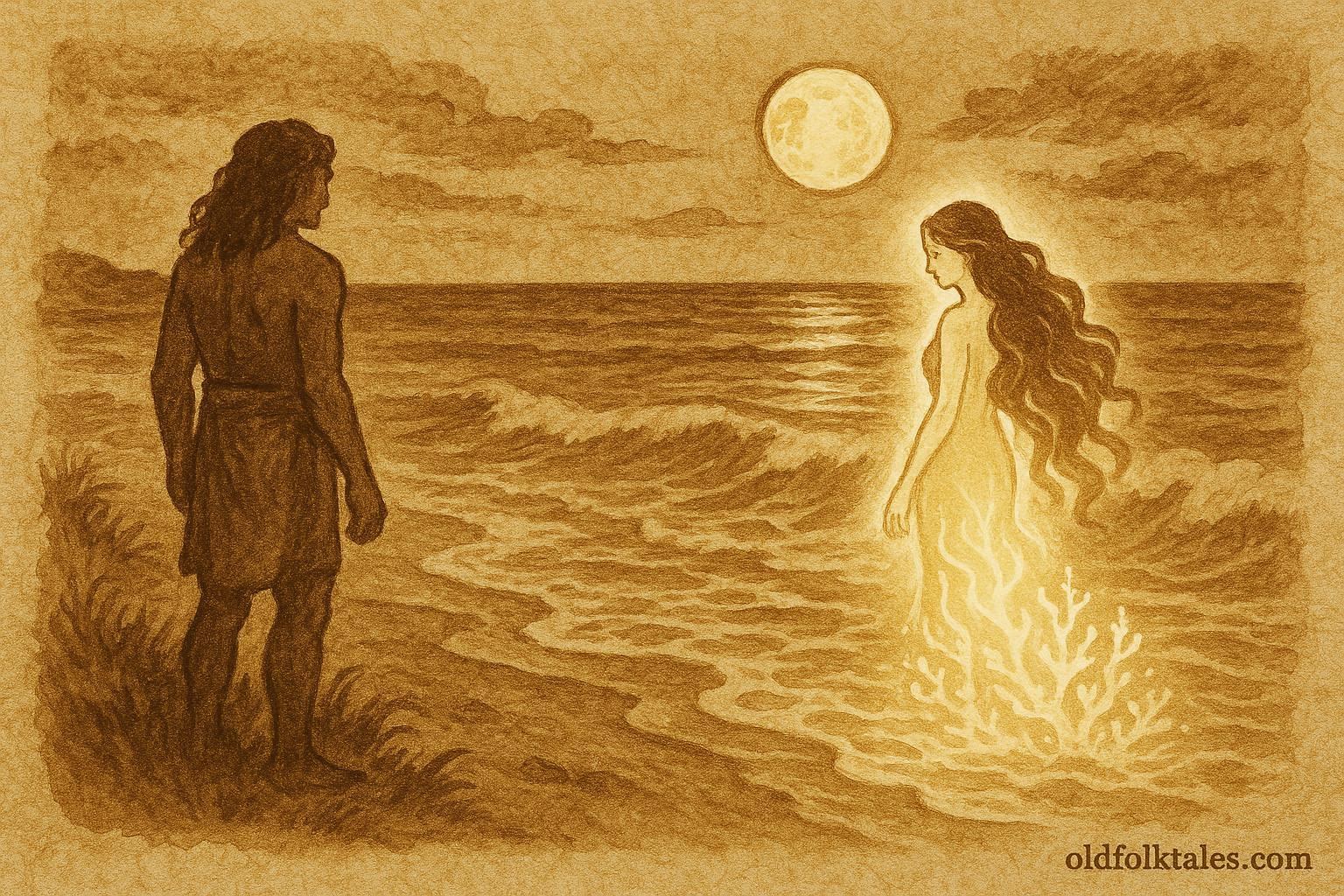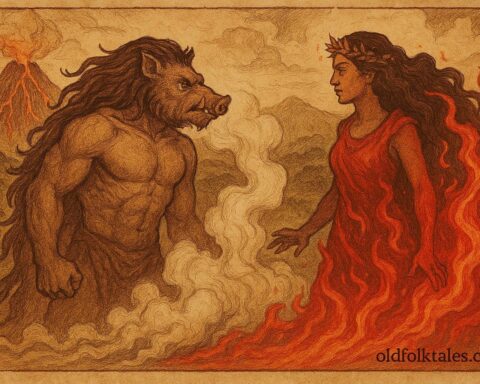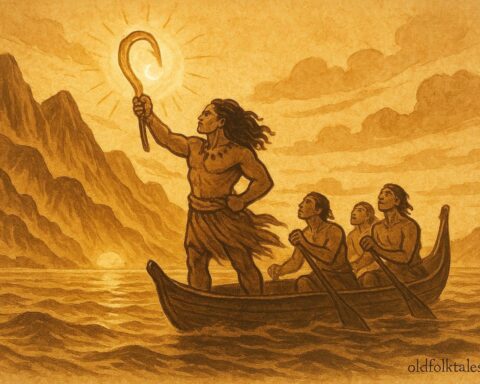Along the glittering coast of Hawke’s Bay, where the waves break gently upon the rocks and the tides sing to the moon, there once lived a maiden named Pania. Her home was beneath the sea, in a realm unseen by mortals, a shimmering underwater world where coral gardens bloomed and the spirits of the ocean danced with the tides. Pania was no ordinary being; she was a sea spirit, graceful and radiant, her hair flowing like kelp in the current, her eyes bright as moonlit water.
Each evening, as dusk fell across Te Whanganui-a-Orotu, Pania would rise from the depths and swim toward the shore. There she listened to the songs and laughter of humankind. She marveled at the firelight flickering across the cliffs, and at the voices that spoke of love, longing, and life on land. Though her world beneath the waves was beautiful, Pania’s heart yearned to know the warmth of the earth and the sound of mortal laughter.
Discover how courage and cleverness shaped the storytelling traditions of Micronesia
The Meeting
One night, as Pania swam near the rocks of Napier, she heard a deep and tender voice singing alone on the shore. Drawn by its sorrowful beauty, she crept closer. There, by the glow of a small fire, sat a young man named Karitoki, a handsome youth of the Ngāti Kahungunu people. He was the son of a chief, known for his skill in fishing and for his kind heart.
When Karitoki looked out toward the sea, he caught sight of Pania’s glowing form half-hidden in the moonlit foam. For a moment, he thought she was a vision, a dream sent by the gods. But when she stepped onto the sand, her eyes met his, and the world seemed to still.
“Who are you?” Karitoki whispered, rising to his feet.
“I am Pania,” she answered softly, her voice like the tide retreating over shells. “I dwell in the waters beyond your shore.”
They spoke through the night, and by dawn, love had bound them as surely as the sea binds the shore. Pania agreed to stay with Karitoki on land, but only under one condition: she must return to the sea each morning, for she belonged to the ocean’s heart. Karitoki promised to honor her wish.
A Life Between Two Worlds
For many moons, the lovers lived in happiness. Pania became cherished among Karitoki’s people for her beauty, gentleness, and wisdom. She taught them to respect the ocean’s gifts, to take only what was needed and to give thanks with each tide. Every dawn, she would slip away before the sun rose high, vanishing beneath the waves to her ocean home.
Yet as time passed, Karitoki’s heart grew restless. He feared that one day Pania might not return, that the sea would claim her forever. His love, once pure, became shadowed by possession and longing. He wished to keep her always by his side, never again to see her disappear into the depths.
So he went to the tohunga, a learned priest, and asked for counsel. “How can I make her stay?” Karitoki pleaded. The priest warned him that the ways of the sea and land must remain in balance, and to force their union would bring misfortune. But Karitoki’s heart was deaf to wisdom. He sought a way to break the bond between Pania and her ocean kin.
The Betrayal
One night, Karitoki invited Pania to share a meal with him. He had placed secret herbs in her food, plants believed to dull the spirit and bind it to the mortal world. “Eat,” he urged gently. “Stay with me through the sunrise, my love. Let the dawn find us together.”
Pania, unaware of his intent, smiled and ate. As the first light of dawn touched the sea, she felt the pull of the ocean deep within her chest, a call she could not ignore. But this time, her strength faltered. She turned to Karitoki, eyes filled with sorrow.
“You have deceived me,” she said softly. “The sea calls, but your trick binds me. Still, I must go, for the ocean is my blood, and to deny it is death.”
She fled from his arms and ran toward the shore. Karitoki followed, calling her name again and again, but she did not turn. As she reached the edge of the waves, the sea opened to receive her. She dove into the surf, and vanished.
The Transformation
Karitoki waited by the shore for days, his heart breaking with each tide that rose and fell. He called to her across the waves, but Pania did not return. Then one morning, as the sun rose over the bay, he noticed something new in the shallows, a stretch of coral glistening in shades of red and gold, shaped like flowing hair and gentle arms.
It was Pania, transformed by the gods into a coral reef, her spirit forever bound between sea and land. From that day onward, the reef became a guardian of the coast, sheltering fish and calming the waves. The people of Napier named it Te Toka-a-Pania, “The Rock of Pania.”
Karitoki would often sit by the water’s edge, whispering her name to the sea breeze. Though grief filled his heart, he found comfort in knowing that Pania still watched over him and his people, her spirit alive in the rhythm of the tides.
To this day, when the waves break gently along the reefs of Napier, the Māori say it is Pania’s song, reminding all who hear it that love, though tested by worlds, never truly dies.
Discover the adventures of Māui, Pele, and Tangaloa in the timeless Polynesian oral tradition
Moral Lesson
Love must honor freedom, for when we try to possess what belongs to the natural world, we risk losing it forever. Pania’s tale teaches reverence for love’s balance, the harmony between giving and letting go.
Knowledge Check
- Who was Pania in Māori legend?
Pania was a sea spirit who fell in love with the mortal man Karitoki in Napier, New Zealand. - Why did Pania return to the sea each morning?
Because she belonged to the ocean’s realm and could not remain long on land without losing her spirit’s power. - What did Karitoki do to make Pania stay with him?
He fed her enchanted herbs meant to bind her to the mortal world. - How did Pania transform into a reef?
After escaping back to the sea, the gods turned her into coral so she could remain close to both land and water. - What is the modern name for the reef linked to this legend?
It is called Te Toka-a-Pania, “The Rock of Pania,” located near Napier. - What lesson does Pania’s story teach?
It teaches respect for love’s freedom, the sacred bond between sea and land, and the enduring power of devotion.
Source: Adapted from Maori Myths and Legends by A.W. Reed (1946).
Cultural Origin: Māori (Ngāti Kahungunu, Hawke’s Bay, New Zealand)












